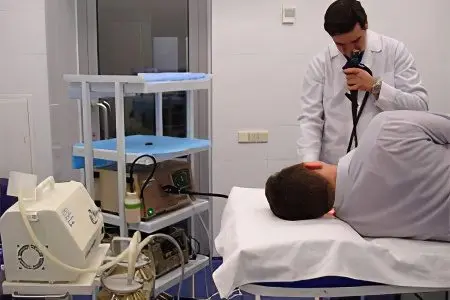Contents

This form of gastroduodenitis is a type of inflammation of the stomach and duodenum with the best prognosis and the least complicated course. Against the background of the pathological process, normal or increased acidity of gastric juice and adequate functioning of the glands are preserved. All structures of the stomach and upper intestines, except for the mucous membrane, with this disease retain their performance. Superficial gastroduodenitis may be the initial stage of other forms of gastritis and duodenitis.
The very name of the disease speaks about how deeply the structures of the stomach and duodenum are affected: the mucosa with superficial gastroduodenitis is slightly inflamed, and this process is reversible.
Disease classification:
According to the form of the course – acute and chronic superficial gastroduodenitis;
By etiology – primary (exogenous) and secondary (endogenous) superficial gastroduodenitis;
Phases according to the degree of inflammation – initial, erosive, atrophic and hypertrophic;
The phases of the course of chronic superficial gastroduodenitis are exacerbation, complete and incomplete remission.
From what acidity (normal, increased or decreased) is observed in the patient’s stomach, the treatment regimen for the disease depends.
Causes of superficial gastroduodenitis

The basis of the inflammatory process in the mucous membrane of the stomach and duodenum is a violation of blood supply.
Factors contributing to the development of superficial gastroduodenitis:
Increased acidity of gastric juice;
Violation of the regenerative ability of the mucous membrane;
Infection with the bacterium Helicobacter pylori;
Toxic damage by poor-quality food;
Alcoholism;
CNS diseases;
Frequent stress and psycho-emotional upheaval;
Irregular meals;
Eating excessively hot or cold food, eating dry food.
Symptoms of superficial gastroduodenitis

Acute manifestations of the disease with a minimal inflammatory process may not be. The most striking symptom is abdominal pain of a aching nature. They appear after eating and as a result of poor nutrition, they give to the navel and under the right rib.
Other symptoms of superficial gastroduodenitis:
Dyspepsia;
Heartburn;
Belching of sour stomach contents;
White coating on the tongue;
Unpleasant taste and smell from the mouth;
Alternating constipation and diarrhea;
Increased salivation;
General weakness and irritability – sleep disturbances, headaches.
With the appearance of dyskinesia and duodeno-gastric reflux, the balance of acidity in the stomach is disturbed, bile is thrown back from the duodenum into the stomach. Because of this, there is a bitter eructation of bile, heartburn, a feeling of heaviness.
With the course of the disease and the appearance of atrophic changes, a deficiency of vitamins of groups A, C, B develops.
Diagnostics

To diagnose and prescribe treatment for this pathology, you should contact a gastroenterologist. The doctor will pay attention to the analysis of the clinical symptoms and complaints of the patient, determine the necessary instrumental and laboratory examination methods:
EGDS (esophagogastroduodenoscopy) – the most informative study to determine the form and stage of the disease;
Detection of the bacterium Helicobacter pylori (PCR diagnostics, ELISA test);
Intragastric pH-metry – determination of the acidity of gastric juice;
Antroduodenal manometry.
It is necessary to differentiate superficial gastroduodenitis from peptic ulcer and functional dyspepsia.
Treatment of superficial gastroduodenitis

Therapy of this disease does not require the placement of the patient in a hospital, it is carried out on an outpatient basis. An important condition for effective treatment and quick recovery is diet and adherence to the diet.
Principles of therapeutic nutrition:
At the beginning of therapy, it is preferable to eat mucous decoctions, pureed soups and cereals, drink compote and jelly;
After 2-3 weeks, the menu includes boiled or steamed meat and fish;
You can not eat fatty and fried foods;
It is forbidden to eat on the run, dry food;
Products that provoke a deterioration in the patient’s condition are excluded.
The treatment regimen for infection with Helicobacter pylori or intestinal infection includes etiotropic therapy with a combination of 2-3 antibiotics.
Groups of drugs used:
Blockers of H2-histamine receptors;
Antacids;
proton pump inhibitors;
The preparation is bismuth;
Anthelmintics (in the presence of worms);
Sedative drugs (for disorders of the nervous system);
Probiotics (to restore the microflora of the stomach and intestines after antibacterial treatment).
The average duration of a medical course of treatment of superficial gastroduodenitis is 10 days. Physiotherapy, the use of folk recipes in the form of medicinal teas and herbal preparations will help restore the functioning of the gastrointestinal tract.
Prognosis and prevention of the disease

If treatment is started in a timely manner, the prognosis for the development of superficial gastroduodenitis is favorable, complications do not occur. With incomplete examination and treatment, failure to comply with the recommendations of the doctor, it is possible to form a stomach and duodenal ulcer, erosion of the mucous membrane, and a malignant tumor. In isolated cases, gastric bleeding may occur.
Preventive action:
Refusal of bad habits (smoking, alcoholism);
Menu and diet optimization;
Mastering relaxation techniques to prevent stress;
Timely examination for the diagnosis of infection with the bacterium Helicobacter pylori and other pathologies of the gastrointestinal tract;
Compliance with the regime of work and rest.









